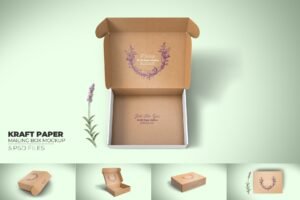In today’s highly competitive cosmetic packaging box market, proper labeling, packaging, and compliance with regulations are not only legal requirements but also crucial for building consumer trust and ensuring the safety and quality of products. This guide provides an in-depth look at the essential aspects of cosmetic labeling, packaging, and regulations.

Required Information (US Federal Fair Packaging and Labeling Act – FPLA)
The US Federal Fair Packaging and Labeling Act (FPLA) sets out specific requirements for cosmetic labeling. This includes providing accurate and clear information about the product’s identity, net quantity, and the name and address of the manufacturer, packer, or distributor. The identity of the product should be prominently displayed and easily understood by consumers. The net quantity must be expressed in a standard unit of measurement and be accurate. The name and address provided should allow consumers to contact the responsible party in case of questions or concerns.
Industry Standards and Common Practices of Cosmetic Packaging Box
The cosmetics industry has its own set of standards and common practices when it comes to labeling and packaging. Cosmetic products typically feature attractive packaging designs that not only protect the product but also appeal to consumers. High-quality materials are often used to ensure durability and prevent damage during transportation and storage. Labeling is designed to be informative and easy to read, with clear fonts and colors. Common practices also include using symbols and icons to convey important information quickly, such as recyclable packaging symbols or allergen warnings.
Ingredients List
An accurate and detailed ingredients list is a must for cosmetic products. Consumers have the right to know what they are putting on their skin or hair. The ingredients should be listed in descending order of predominance, with the most abundant ingredient first. All ingredients must be identified using their standardized names. This helps consumers identify potential allergens or ingredients they may want to avoid. Additionally, some ingredients may require special labeling, such as those that are known to cause irritation or are considered hazardous.
Usage Instructions
Clear usage instructions are essential to ensure that consumers use the product correctly and safely. This may include information on how to apply the product, how often to use it, and any special precautions or considerations. For example, a skincare product may have specific instructions on when to apply it in a daily routine or whether it should be used with other products. Makeup products may include instructions on how to apply for the best results.
Warnings and Precautions
Cosmetic products may carry certain risks or potential side effects, and it is important to provide warnings and precautions on the label. This could include warnings about allergic reactions, skin irritation, or potential interactions with other products. For products that are not suitable for certain groups of people, such as pregnant women or those with sensitive skin, specific warnings should be included. Additionally, if the product contains ingredients that require special handling or storage, such as flammable substances or products that need to be kept out of direct sunlight, these precautions should be clearly stated.
Marketing Claims
Cosmetic labels often feature marketing claims that are designed to attract consumers. However, these claims must be truthful and substantiated. Claims such as “organic,” “natural,” “hypoallergenic,” or “anti-aging” need to be supported by scientific evidence. Misleading or false claims can lead to legal consequences and damage to a brand’s reputation. Marketers should ensure that their claims are in line with regulatory requirements and industry standards.
Batch Code
A batch code is a unique identifier that allows manufacturers and regulators to track and trace a product. It can be used to determine when and where a product was made, as well as to identify any potential issues or recalls. Batch codes are typically printed on the packaging and may be in the form of a number, letter combination, or barcode. Consumers should be able to easily find and understand the batch code on the product.
Additional Considerations For Cosmetic Labeling and Packaging

Sustainability
In recent years, there has been a growing demand for sustainable cosmetic packaging. Consumers are increasingly concerned about the environmental impact of packaging waste and are looking for products that use eco-friendly materials and packaging designs. This could include using recyclable materials, reducing packaging waste, or incorporating sustainable practices into the manufacturing process. Brands that prioritize sustainability can attract environmentally conscious consumers and contribute to a more sustainable future.
Functionality
The packaging of cosmetic products should not only look good but also be functional. This means that it should protect the product from damage, prevent leakage, and be easy to use. Packaging designs should consider factors such as portability, ease of opening and closing, and dispensing mechanisms. For example, a lipstick may have a twist-up mechanism for easy application, while a skincare product may have a pump or dropper for precise dispensing.
Regulations and Compliance
Compliance with regulations is essential for cosmetic manufacturers and marketers. In addition to federal regulations, such as the FPLA, there may be state laws and international regulations that apply. Manufacturers should stay up-to-date with the latest regulatory requirements and ensure that their products meet all applicable standards. This may involve conducting regular audits, testing products for safety and quality, and maintaining accurate records.
State Laws
Some states may have their own laws and regulations regarding cosmetic labeling and packaging. These laws may be more stringent than federal requirements or may address specific issues not covered by federal law. For example, some states may have requirements for labeling products that contain certain ingredients or for disclosing the source of ingredients. Manufacturers and marketers should be aware of state laws and ensure compliance to avoid potential legal issues.
International Regulations
If a cosmetic product is intended for export or sale in international markets, it must comply with the regulations of the destination country. International regulations may vary significantly from country to country, and manufacturers need to understand and adapt to these differences. This could include requirements for labeling, packaging materials, ingredient restrictions, and safety testing. Working with experienced international distributors or consultants can help ensure compliance with international regulations.
In Conclusion
Proper cosmetic labeling, packaging, and compliance with regulations are essential for the success of any cosmetic product. By providing accurate and clear information, using sustainable and functional packaging, and adhering to regulatory requirements, manufacturers and marketers can build consumer trust, enhance brand reputation, and ensure the safety and quality of their products. As the cosmetics industry continues to evolve, it is important to stay informed about the latest trends and regulations to meet the changing needs and expectations of consumers.






